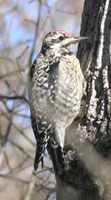Prevention and Control
 The most effective way to control problem birds is to understand their daily requirements, and remove or exclude these. This kind of manipulation for purposes of increasing or decreasing numbers is an important part of wildlife management. Some basic principles provide a background for understanding how to control problem birds effectively and appropriately.
The most effective way to control problem birds is to understand their daily requirements, and remove or exclude these. This kind of manipulation for purposes of increasing or decreasing numbers is an important part of wildlife management. Some basic principles provide a background for understanding how to control problem birds effectively and appropriately.
To survive, all wild animals need habitat , which is comprised of four essential elements: space, food, shelter and water. Wildlife managers manipulate these elements to attract and maintain wildlife species and control problem species.
Space is the area needed by a wild animal. Just as some people are happy in a city apartment while others need a sprawling ranch, some birds need more space than others. In reference to wild animals, there are two kinds of space:
- home range - the entire area that an animal uses to eat, sleep, and go about its daily activities;
- territory - that portion of the home range an animal defends against intruders, usually where it raises young.
In most cases, the male bird establishes and defends the territory. In the spring the brightly colored male sings to attract a mate and to announce to other male birds of the same species the location of his territorial space. After the pair builds a nest, the male continues to defend the territory while the female hatches eggs. This factor cannot be controlled because space is determined by the area of a yard or farmstead.
Food, water and shelter are elements that can be manipulated to manage birds in the yard or other urban setting. Providing these attracts birds; removing them keeps birds away. All are essential, yet not all bird problems can be eliminated by taking away just one element.
Variety is a key word in wildlife management. It is often necessary to use a variety of excluding and repelling methods simultaneously to control nuisance birds.
Food sources for birds include seeds, fruits, berries and insects. To reduce the number of problem birds, eliminate or control their access to food. Strategies for controlling problem birds around homes are often different from those needed around farmsteads. The homeowner may reduce the number of undesirable birds by choosing plants that do not produce edible nuts, fruits and berries, or by changing the type of food offered in bird feeders.
Variety is necessary for successful bird damage control. Use different methods, and change them so birds do not become accustomed to them.